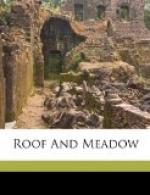Ahead of me the even green broke suddenly over a shoal of sand into tall, tufted grasses, into rose, mallow, and stunted persimmon bushes, foaming, on nearer view, with spreading dogbane blossoms. Off toward the bay another of these shoals, mole-hill high in the distance, ran across the marsh for half a mile, bearing a single broken file of trees—sentinels they seemed, some of them fallen, others gaunt and wind-beaten, watching against the sea.
These were the lookouts and the resting-places for passing birds. During the day, whenever I turned in their direction, a crow, a hawk, or some smaller bird was seen upon their dead branches.
Naturally the variety of bird life upon the marsh is limited; but there is by no means the scarcity here which is so often noted in the forests and wild prairies of corresponding extent. Indeed, the marsh was birdy—rich in numbers if not in species. Underfoot, in spots, sang the marsh-wrens; in larger patches the sharp-tailed sparrows; and almost as wide-spread and constant as the green was the singing of the seaside sparrows. Overhead the fish-hawks crossed frequently to their castle nest high on the top of a tall white oak along the land edge of the marsh; in the neighborhood of the sentinel trees a pair of crows were busy trying (it seemed to me) to find an oyster, a crab—something big enough to choke, for just one minute, the gobbling, gulping clamor of their infant brood. But the dear devouring monsters could not be choked, though once or twice I thought by their strangling cries that father crow, in sheer desperation, had brought them oysters with the shells on. Their awful gaggings died away at dusk. Besides the crows and fish-hawks, a harrier would now and then come skimming close along the grass. Higher up, the turkey-buzzards circled all day long; and once, setting my blood leaping and the fish-hawks screaming, there sailed over, far away in the blue, a bald-headed eagle, his snowy neck and tail flashing in the sunlight as he careened among the clouds.
In its blended greens the marsh that morning offered one of the most satisfying drinks of color my eyes ever tasted. The areas of different grasses were often acres in extent, so that the tints, shading from the lightest pea-green of the thinner sedges to the blue-green of the rushes, to the deep emerald-green of the hay-grass, merged across their broad bands into perfect harmony.
As fresh and vital as the color was the breath of the marsh. There is no bank of violets stealing and giving half so sweet an odor to my nostrils, outraged by a winter of city smells, as the salty, spray-laden breath of the marsh. It seems fairly to line the lungs with ozone. I know how grass-fed cattle feel at the smell of salt. I have the concentrated thirst of a whole herd when I catch that first whiff of the marshes after a winter, a year it may be, of unsalted inland air. The smell of it stampedes me. I gallop to meet it, and drink, drink, drink deep of it, my blood running redder with every draught.




